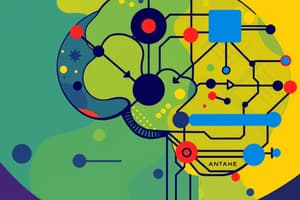Podcast
Questions and Answers
Which step in computational thinking involves breaking down problems into manageable components?
Which step in computational thinking involves breaking down problems into manageable components?
- Pattern Recognition
- Algorithm
- Decomposition (correct)
- Abstraction
What is the primary purpose of abstraction in computational thinking?
What is the primary purpose of abstraction in computational thinking?
- To create an ordered sequence of steps to follow
- To identify and utilize the structure of main ideas (correct)
- To ensure all details are analyzed equally
- To develop a detailed list of every component of a problem
Pattern recognition in data is used to:
Pattern recognition in data is used to:
- Break down problems into their respective components
- List all possible solutions to a problem
- Create complex algorithms from scratch
- Observe trends and regularities to facilitate problem-solving (correct)
Which of the following is NOT a characteristic of an algorithm in computational thinking?
Which of the following is NOT a characteristic of an algorithm in computational thinking?
What is a key benefit of using decomposition in problem-solving?
What is a key benefit of using decomposition in problem-solving?
Which method in computational thinking focuses on managing complexity through simplification?
Which method in computational thinking focuses on managing complexity through simplification?
In computational thinking, recognizing patterns can lead to:
In computational thinking, recognizing patterns can lead to:
Which method involves breaking down complex systems into simpler parts in biological studies?
Which method involves breaking down complex systems into simpler parts in biological studies?
Which computational thinking method involves following a structured sequence of steps?
Which computational thinking method involves following a structured sequence of steps?
What type of model simplifies data to make human genomes understandable?
What type of model simplifies data to make human genomes understandable?
In which area is pattern recognition particularly applied to identify similarities in data?
In which area is pattern recognition particularly applied to identify similarities in data?
What is an example of an algorithm in everyday life?
What is an example of an algorithm in everyday life?
How do companies utilize decomposition in their structure?
How do companies utilize decomposition in their structure?
Which method is employed in legal settings to ensure consistency and reduce bias?
Which method is employed in legal settings to ensure consistency and reduce bias?
Which scientific approach involves studying the Earth's structure and its resources?
Which scientific approach involves studying the Earth's structure and its resources?
What is the role of abstraction in art, as described in the content?
What is the role of abstraction in art, as described in the content?
Study Notes
Computational Thinking Competencies
- Computational thinking is the use of cognitive skills to solve problems.
- Computational thinking involves calculations, amounts, and results.
- Competencies are important skills that are needed to do a job.
Computational Thinking Methods
- Computational thinking uses the following methods:
- Decomposition
- Abstraction
- Pattern Recognition
- Algorithms
Decomposition
- Breaks down data, processes, or problems into smaller and manageable components.
- Each part is analyzed and solved by different parties.
- This provides various perspectives.
- Also known as the divide-and-conquer strategy.
Abstraction
- Identifies and uses the main ideas of a concept.
- Highlights important information.
- Ignores unimportant details.
- Simplifies complexity.
Pattern Recognition
- Recognizes patterns, trends, and regularities in data.
- Identifies similarities and differences between problems.
- Makes problems simpler to solve.
- The same solution can be applied to problems with the same pattern.
Algorithms
- Ordered instructions for how to perform a task.
- They establish order in complex processes.
- Algorithms can be used in programming and everyday life.
Real-life examples of Computational Thinking
- Biology:
- Decomposition: Biological decomposers (fungi, bacteria)
- Abstraction: Human Genome modeling (simplified models of complex structures)
- Pattern Recognition: Categorization of biological processes (gene finding, biomarkers, protein synthesis)
- English language Arts:
- Abstraction: Book synopsis
- Algorithms: Traditional poetry structure (verse and rhyme)
- Decomposition: Essay outline
- Pattern Recognition: Phonics and spelling
- Computer Science:
- Decomposition: Functions and Factorials
- Abstraction: Pseudocode
- Pattern Recognition: Machine learning, AI, probability and statistics
- Algorithms: IF ELSE, Algorithm efficiency
- Singapore MRT map: Abstraction (shows only stations, without complex details)
- Instructions to build a chair: Algorithm (like recipes)
- Candy crush game: Pattern Recognition (matching similar items)
- Abstraction in Art: Symbols have been used as a form of communication throughout history.
- Algorithms in Legal Settings: Standardized processes in legal systems to ensure consistency and minimize bias.
- The legislative process: Bill introduction → Debate → Vote → Presidential approval.
- Decomposition in Piggy Bank Counting: Sorting coins by value to simplify counting.
- Decomposition in Companies: Companies are organized into departments, divisions, and teams with specialized roles.
- Pattern Recognition in Geology: Studying the Earth's structure, evolution, and resources. (e.g., Pangaea).
Advantages / Disadvantages of Computational Thinking
- Computational Thinking is about using cognitive skills to solve problems.
- It has advantages and disadvantages, similar to other methods.
- It is a valuable skill for anyone who wants to be successful in the 21st century.
Quantitative Reasoning and Techniques
- Quantitative Reasoning (QR) is important for data analysis.
- Steps to obtain data insights:
- (List of steps to be added in the next turn)
Studying That Suits You
Use AI to generate personalized quizzes and flashcards to suit your learning preferences.
Related Documents
Description
This quiz explores the key components of computational thinking including its competencies and various methods such as decomposition, abstraction, and pattern recognition. Participants will enhance their understanding of how to approach problem-solving using these techniques. Test your knowledge on these essential skills for effective job performance.




